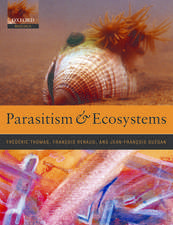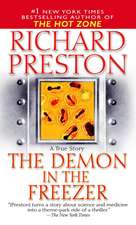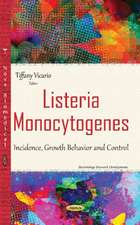Diagnostic Bacteriology Protocols: Methods in Molecular Biology, cartea 345
Editat de Louise O’Connoren Limba Engleză Paperback – 19 noi 2010
| Toate formatele și edițiile | Preț | Express |
|---|---|---|
| Paperback (1) | 637.93 lei 6-8 săpt. | |
| Humana Press Inc. – 19 noi 2010 | 637.93 lei 6-8 săpt. | |
| Hardback (1) | 644.30 lei 6-8 săpt. | |
| Humana Press Inc. – 21 apr 2006 | 644.30 lei 6-8 săpt. |
Din seria Methods in Molecular Biology
- 9%
 Preț: 791.59 lei
Preț: 791.59 lei - 23%
 Preț: 598.56 lei
Preț: 598.56 lei - 20%
 Preț: 882.95 lei
Preț: 882.95 lei -
 Preț: 252.04 lei
Preț: 252.04 lei - 5%
 Preț: 802.69 lei
Preț: 802.69 lei - 5%
 Preț: 729.61 lei
Preț: 729.61 lei - 5%
 Preț: 731.43 lei
Preț: 731.43 lei - 5%
 Preț: 741.30 lei
Preț: 741.30 lei - 5%
 Preț: 747.16 lei
Preț: 747.16 lei - 15%
 Preț: 663.45 lei
Preț: 663.45 lei - 18%
 Preț: 1025.34 lei
Preț: 1025.34 lei - 5%
 Preț: 734.57 lei
Preț: 734.57 lei - 18%
 Preț: 914.20 lei
Preț: 914.20 lei - 15%
 Preț: 664.61 lei
Preț: 664.61 lei - 15%
 Preț: 654.12 lei
Preț: 654.12 lei - 18%
 Preț: 1414.74 lei
Preț: 1414.74 lei - 5%
 Preț: 742.60 lei
Preț: 742.60 lei - 20%
 Preț: 821.63 lei
Preț: 821.63 lei - 18%
 Preț: 972.30 lei
Preț: 972.30 lei - 15%
 Preț: 660.49 lei
Preț: 660.49 lei - 5%
 Preț: 738.41 lei
Preț: 738.41 lei - 18%
 Preț: 984.92 lei
Preț: 984.92 lei - 5%
 Preț: 733.29 lei
Preț: 733.29 lei -
 Preț: 392.58 lei
Preț: 392.58 lei - 5%
 Preț: 746.26 lei
Preț: 746.26 lei - 18%
 Preț: 962.66 lei
Preț: 962.66 lei - 23%
 Preț: 860.21 lei
Preț: 860.21 lei - 15%
 Preț: 652.64 lei
Preț: 652.64 lei - 5%
 Preț: 1055.50 lei
Preț: 1055.50 lei - 23%
 Preț: 883.85 lei
Preț: 883.85 lei - 19%
 Preț: 491.88 lei
Preț: 491.88 lei - 5%
 Preț: 1038.84 lei
Preț: 1038.84 lei - 5%
 Preț: 524.15 lei
Preț: 524.15 lei - 18%
 Preț: 2122.34 lei
Preț: 2122.34 lei - 5%
 Preț: 1299.23 lei
Preț: 1299.23 lei - 5%
 Preț: 1339.10 lei
Preț: 1339.10 lei - 18%
 Preț: 1390.26 lei
Preț: 1390.26 lei - 18%
 Preț: 1395.63 lei
Preț: 1395.63 lei - 18%
 Preț: 1129.65 lei
Preț: 1129.65 lei - 18%
 Preț: 1408.26 lei
Preț: 1408.26 lei - 18%
 Preț: 1124.92 lei
Preț: 1124.92 lei - 18%
 Preț: 966.27 lei
Preț: 966.27 lei - 5%
 Preț: 1299.99 lei
Preț: 1299.99 lei - 5%
 Preț: 1108.51 lei
Preț: 1108.51 lei - 5%
 Preț: 983.72 lei
Preț: 983.72 lei - 5%
 Preț: 728.16 lei
Preț: 728.16 lei - 18%
 Preț: 1118.62 lei
Preț: 1118.62 lei - 18%
 Preț: 955.25 lei
Preț: 955.25 lei - 5%
 Preț: 1035.60 lei
Preț: 1035.60 lei - 18%
 Preț: 1400.35 lei
Preț: 1400.35 lei
Preț: 637.93 lei
Preț vechi: 750.50 lei
-15% Nou
Puncte Express: 957
Preț estimativ în valută:
122.06€ • 127.45$ • 101.03£
122.06€ • 127.45$ • 101.03£
Carte tipărită la comandă
Livrare economică 04-18 aprilie
Preluare comenzi: 021 569.72.76
Specificații
ISBN-13: 9781617376665
ISBN-10: 1617376663
Pagini: 226
Ilustrații: X, 226 p. 51 illus.
Dimensiuni: 152 x 229 x 14 mm
Greutate: 0.35 kg
Ediția:Softcover reprint of hardcover 2nd ed. 2006
Editura: Humana Press Inc.
Colecția Humana
Seria Methods in Molecular Biology
Locul publicării:Totowa, NJ, United States
ISBN-10: 1617376663
Pagini: 226
Ilustrații: X, 226 p. 51 illus.
Dimensiuni: 152 x 229 x 14 mm
Greutate: 0.35 kg
Ediția:Softcover reprint of hardcover 2nd ed. 2006
Editura: Humana Press Inc.
Colecția Humana
Seria Methods in Molecular Biology
Locul publicării:Totowa, NJ, United States
Public țintă
ResearchCuprins
A Review of Current and Future Molecular Diagnostic Tests for Use in the Microbiology Laboratory.- Overview of DNA Purification for Nucleic Acid-Based Diagnostics From Environmental and Clinical Samples.- Microarray-Based Detection of Bacteria by On-Chip PCR.- An Array Biosensor for Detection of Bacterial and Toxic Contaminants of Foods.- Detection of Neisseria meningitidis, Streptococcus pneumoniae, and Haemophilus influenzae in Blood and Cerebrospinal Fluid Using Fluorescence-Based PCR.- Use of Hybridization Probes in a Real-Time PCR Assay on the LightCycler® for the Detection of Methicillin-Resistant Staphylococcus aureus.- Detection of Verotoxin Genes VT 1 and VT 2 in Escherichia coli O157:H7 in Minced Beef Using Immunocapture and Real-Time PCR.- Application of Two-Step Quantitative Reverse-Transcription PCR to Bacterial Diagnostics.- Quencher Extension for Single Nucleotide Polymorphism Quantification in Bacterial Typing and Microbial Community Analyses.- Amplified Fragment-Length Polymorphism and Protein Profiling for Identification of Campylobacter lari Subgroups.- Use of Peptide Nucleic Acid Probes for Rapid Detection and Enumeration of Viable Bacteria in Recreational Waters and Beach Sand.- HOOF Prints.- Detection of Legionella in Various Sample Types Using Whole-Cell Fluorescent In Situ Hybridization.- Identification of Diagnostic Proteins in Mycobacterium avium subspecies paratuberculosis by a Whole Genome Analysis Approach.- Diagnosis of Q Fever Using Indirect Microimmunofluorescence.- Macrophage Cell Cultures for Rapid Isolation of Intracellular Bacteria.
Recenzii
From the reviews:
"The text is lucid and wonderfully brief...The techniques described have universal application to bacteriological analyses regardless of one's special interests or focus...a well and necessary addendum for all laboratories engaged in or planning to perform bacterial identifications..." -Quarterly Review of Biology
"...a useful addition to the portfolio of bioscience laboratories" -Microbiology Today
"A very useful book for the bench scientist interested in techniques for differentiating bacterial isolates...should prove useful in a wide range of industrial and academic applications." -Doody's Health Sciences Book Review Journal
"...undoubtedly a useful addition to the series and would be of use to research scientists." -Journal of Clinical Pathology
From the reviews of the second edition:
"This concise volume contains simple introductions to many techniques to supplement the traditional agar plate … . The text is easy and clear to follow … . the aim of the book is to provide ideas. The chapters can, therefore, be read for inspiration … . Step-by-step guide to many of the procedures are included, so those about to embark on a new technique, or even those simply wanting to understand the principles … will be able to benefit. … A handy reference … ." (Dr. J Cargill, acp News, Winter, 2006)
"This very practical volume provides concise, state of the art molecular diagnostic bacteriology protocols for a range of species … . In my view this book provides a valuable additional source of applied protocols for scientists interested in the detection and differentiation of bacteria … . I strongly recommend this book for purchase by laboratory-based scientists interested in bacterial detection and differentiation." (David C. Coleman, SGM- Society for General Microbiology, 2007)
"The hard-cover publication in A5 format amounting to 225 pages including a six-page indexcontains 16 chapters … . The book is thus a valuable aid both for beginning and for experienced laboratory workers. … Diagnostic Bacteriology Protocols will be used both by experienced molecular biologists for whom it is a source of extending their used techniques, and by beginning specialists with basic knowledge of diagnostic procedures in molecular biology. The uniform and clear treatment offers very good orientation in the flood of ever-emerging facts." (E. Pavlík, Folia Microbiologica, December, 2007)
"The text is lucid and wonderfully brief...The techniques described have universal application to bacteriological analyses regardless of one's special interests or focus...a well and necessary addendum for all laboratories engaged in or planning to perform bacterial identifications..." -Quarterly Review of Biology
"...a useful addition to the portfolio of bioscience laboratories" -Microbiology Today
"A very useful book for the bench scientist interested in techniques for differentiating bacterial isolates...should prove useful in a wide range of industrial and academic applications." -Doody's Health Sciences Book Review Journal
"...undoubtedly a useful addition to the series and would be of use to research scientists." -Journal of Clinical Pathology
From the reviews of the second edition:
"This concise volume contains simple introductions to many techniques to supplement the traditional agar plate … . The text is easy and clear to follow … . the aim of the book is to provide ideas. The chapters can, therefore, be read for inspiration … . Step-by-step guide to many of the procedures are included, so those about to embark on a new technique, or even those simply wanting to understand the principles … will be able to benefit. … A handy reference … ." (Dr. J Cargill, acp News, Winter, 2006)
"This very practical volume provides concise, state of the art molecular diagnostic bacteriology protocols for a range of species … . In my view this book provides a valuable additional source of applied protocols for scientists interested in the detection and differentiation of bacteria … . I strongly recommend this book for purchase by laboratory-based scientists interested in bacterial detection and differentiation." (David C. Coleman, SGM- Society for General Microbiology, 2007)
"The hard-cover publication in A5 format amounting to 225 pages including a six-page indexcontains 16 chapters … . The book is thus a valuable aid both for beginning and for experienced laboratory workers. … Diagnostic Bacteriology Protocols will be used both by experienced molecular biologists for whom it is a source of extending their used techniques, and by beginning specialists with basic knowledge of diagnostic procedures in molecular biology. The uniform and clear treatment offers very good orientation in the flood of ever-emerging facts." (E. Pavlík, Folia Microbiologica, December, 2007)
Textul de pe ultima copertă
Carrying on the high standards of the much respected first edition, Diagnostic Bacteriology Protocols, Second Edition, has been fully updated to include the novel identification, detection, and typing technologies that are transforming the field of diagnostic testing. The authors, working at the forefront of diagnostic test development, highlight these new technologies and describe current and future molecular diagnostic tests and related nucleic acid extraction methods. The protocols range from advanced molecular detection, quantification, and typing systems, to protocols for diagnostic protein identification, serological testing, and cell culture-based assays. The emphasis is on nucleic acid-based diagnostics and alternative biochemically and immunologically based formats that can provide significant potential for multiparameter testing and automation. Several protocols describe specific organisms that may be easily modified to detect other species of interest. The protocols follow the successful Methods in Molecular Biology™ series format, each offering step-by-step laboratory instructions, an introduction outlining the principles behind the technique, lists of the necessary equipment and reagents, and tips on troubleshooting and avoiding known pitfalls.
Forward looking and highly practical, Diagnostic Bacteriology Protocols, Second Edition illuminates the cutting-edge technologies now available for bacterial pathogen detection and identification and demonstrates their power and ease of use in a wide variety of applications.
Forward looking and highly practical, Diagnostic Bacteriology Protocols, Second Edition illuminates the cutting-edge technologies now available for bacterial pathogen detection and identification and demonstrates their power and ease of use in a wide variety of applications.
Caracteristici
Includes supplementary material: sn.pub/extras












